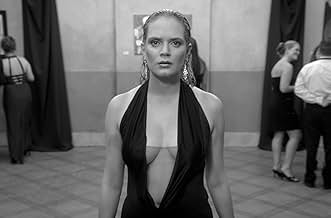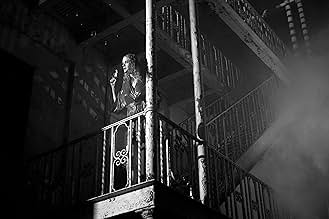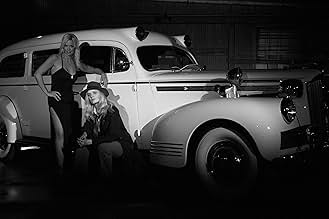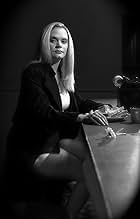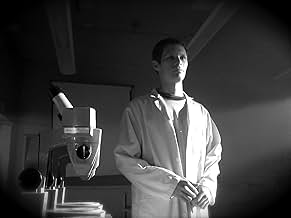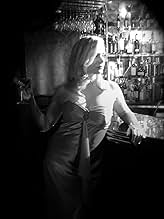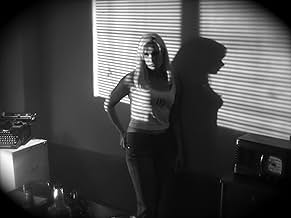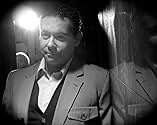Agrega una trama en tu idiomaHoyle, a girl with a sharp mind and a weakness for bourbon, finds herself on the trail of a reclusive genius. But her work takes a series of unforeseen twists as events around her grow incre... Leer todoHoyle, a girl with a sharp mind and a weakness for bourbon, finds herself on the trail of a reclusive genius. But her work takes a series of unforeseen twists as events around her grow increasingly fragmented... disconnected... surreal. With an ethereal lounge singer and her loya... Leer todoHoyle, a girl with a sharp mind and a weakness for bourbon, finds herself on the trail of a reclusive genius. But her work takes a series of unforeseen twists as events around her grow increasingly fragmented... disconnected... surreal. With an ethereal lounge singer and her loyal partner as her only allies, Hoyle is plunged into a dark world of intrigue and earth-sha... Leer todo
- Dirección
- Guionista
- Elenco
- Premios
- 11 premios ganados en total
- Bartender
- (as Joe Leroy Reynolds Jr.)
- Dirección
- Guionista
- Todo el elenco y el equipo
- Producción, taquilla y más en IMDbPro
Opiniones destacadas
The film exemplifies Godard's maxim that all it takes to make a movie is a girl and a gun. In this case the lead female characters are two lovely blondes. Each so cleverly resembles the other that one is reminded of Discreet Object of Desire, the surrealist flick where two actresses played one character.
But adding layers of complexity here, these twin-like actresses are also playing the left and right sides of the brain of the feminine anima of one male character. Got that? They all meet at the Pigeon Hole lounge. The first character is the young Hoyle, a feminine Bogart/Sam Spade analytic detective - the left brain. Like Sam she likes the gin and the story straight. The second is a sultry, un-named singer who has a familiarity with the poetics of T.S. Eliot - the brain's right. Her music is entrancing, her wit intuitive and nonlinear. Together, these two provide the counterpoint of Jung's anima to the male animus of the main character, Dudas.
Whether Hoyle and her counterpart, Singer, convince us they are our anima is irrelevant as we so want them to be part of us. These lovelies draw us ever so seductively into imagining the dark recesses of our own beautiful unconscious, despite whatever misgivings. All we're here for is love, we are told. The shape of the universe is a relationship - functional or otherwise - whether with our inner parts or with our fellow beings. This makes for a strange little Jungian romp in luscious b&w footage. This is Lynch with an underlying premise. Somewhat like the film Pi, this low budget beauty was made at the cost of Pi (made at $60,000) times pi!
First time director James Kerwin makes for a Jungian fortune teller taking us on a trip to disentangle or re-entangle our male and female halves. Kerwin is an urban shaman who shows us the conventional mind as a "surge suppressor". Our conscious minds filter small broken bits of time in a lame attempt to tell a story. Does it matter whether they "add up"?
Beginning with some obvious allegory, the locks are broken off the allegorical unconscious and our character, curiously named Hoyle bravely walks into a poetic film noir journey to confront the Self. (Hoyle seems named after transcendental astronomer/physicist Fred Hoyle who was deeply intrigued by the "Anthropic Principle" of nature.) We begin with a look at Dali's surrealist masterpiece Persistence of Memory in a hallway. They meet Schrödinger's cat, the parable of which tells us there are opposite angles on everything and only by choosing do we arrives at any definitive perspective. Free Will is discussed. The film reveals a Jungian Fenestra Aeternitatus, a window to the eternal, that our characters need to navigate.
A variety of other cutting edge consciousness theories are peppered throughout the film to spice the intellectual interest of the knowledgeable viewer, including pondering Planck's constant, a number describing the fundamental vibration at the Ground of Being. For those less informed, the film literally goes back to the psychiatrist to explain itself. Jung, we are told, said a man needs to project his animus onto the feminine anima in order to unlock the secrets of the universe. This is a film for men who are in need of seeing themselves and for women who want a deeper look into those men. What does a man see in himself as a woman?
Hoyle goes into a dream within a dream (hasn't everyone had at least one of these?) to contact her animus, Dudas, who has a notebook of important thoughts or ideas. Meanwhile we are constantly asked, what if our theories, concepts of self, and common sense don't add up? And what does that tell us about our relationships? And what is the nature and consequence of the loss of "relationship"? The right-sided feminine asks the questions. Left-sided Hoyle tries to read the tea leaves, the pattern in the chaos. Hoyle and her doppelganger meet another aspect of their animus, a scientist who explains the nature of time and who feels these two sexy blondes are "better" and "better". They are also the choices that interface with reality. They will help us overcome our own guilt about our very existence and the broken promises to ourselves and to others.
A deep understanding of time is seen in this film's Feynman diagram writ large in cinema. Physicist Feynman showed everything else might be one mind/particle bouncing backwards and forwards in time, appearing as each and all of us trying to make contact with every part of experience over eternity, the very fabric of time. This reach for the eternal is countered by the Shadow, the dark side, who delivers a bit of lead poisoning in the form of bullets. Death's shadow is a terrifying/exhilarating lockdown on the many-sided reality of now, it haunts our Selves. It occurs when we bring our stories to a halt. We need to let go of our life-text and grab onto our fuller selves, leaving our memories to be what they are and move on to script ourselves anew.
This film is an ultimate romance with "The Other", a mix of the cosmos and the chaos, the order and the disorder, the male and the female. In this cocktail lounge of our emotions, letting go of our primordial selfishness lets our unconscious sing its own songs, reconciling the Self to itself. And pay attention to terrific music in here. Chase Masterson sings beautifully the lounge songs of our longing.
The film slowly curves to an almost-campy feel. The noir aspect is done just right, not too fuzzy, not too sharp. Most of the lines in the script are properly adept to the 30's and 40's. It falls short just enough to hint there's more to this film than a noir satire, but in the beginning doesn't take itself too seriously... quite yet. This allows the viewer to enjoy certain aspects of the film without being forced to delve too deeply into the philosophical paradoxes. But there's an overriding uneasy feeling that's a portent of what's to come.
The last third of the film is when they pour it on, and the foundation they've built to that point begins to hit paydirt. There are some brilliant ideas and lines here (although not original, still interesting to follow). If the viewers have stuck through the semi-cerebral dialog to this point they're likely to stick with it to the reveal. And there is a reveal... but it's just enough to hint at what's happening rather than spoil the mystery. Ordinarily I hate films that leave the viewer to figure out the purpose of the film, but in this case it works.
The acting starts out questionable. It's not good, not bad, some of it decidedly hammy where it fits. When it comes to the lead actress, acting isn't her prominent attraction. She's there to catch and hold initial attention while the writers and directors build the plot line. The supporting actors are sufficient to the job, but no one but the lead actress pushes their role too much. The lead actress does. Her acting gets better halfway through as the plot solidifies. This all is evidently by intent, initially making you question her role, then seeing that role developed and defined as the story unfolds.
Especially impressive are the sets and backgrounds. Simple and clean yet precisely period. The lighting is great (especially in the final scene) as is the use of fog and steam throughout the film. In this it's the little things that count, and the director uses them efficiently.
At first I was going to give this film a 5 star mediocre rating, but it kept getting better as it went along. At the end I realized the director skillfully pulled us along exactly as intended, tricking us by making us wonder whether this was a serious film or a satire. They made sure the question marks were in all the right places but the answers never quite handed to us on a platter. In the end if we've been paying attention we figure out what happened, but aren't quite sure we've figured it right. That aspect is surprisingly and very unusually satisfying. As stated prior, I usually hate questionable-ending films. Not hating it in this film indicates a decided mark of skill in the presentation.
Not a "brilliant" film, but somewhat in a class of its own. It's one of the best uses of neo-noir I've seen, with the plot both coming together and unraveling at the same time. That's a tricky balance, but one I feel they pulled off successfully.
Short form, if you've seen other films noir, you've seen this one, except done better. If you've seen a lot of film noir, you've seen everything in this one, because it seems to be little more than a visual mash-up of what's been done before.
That in itself is bad enough, but the acting and the writing are atrocious. If you saw Super 8, at the end of the film you get the see the project film that all the kids are working on throughout the movie. "Yesterday was a Lie" is very slightly better than that. Given that the writer is also the director, and based on the fact that every performance is flat and fails to engage, I think the direction must also be at fault.
There is philosophy to be found here. I would urge you to read up on mysticism and physics (particularly quantum mechanics) instead of spending your time on this movie. You'll learn a lot more, and in the end you will have spent your time more wisely.
¿Sabías que…?
- ConexionesFollowed by The Making of 'Yesterday Was a Lie': Featurette (2010)
Selecciones populares
- How long is Yesterday Was a Lie?Con tecnología de Alexa
Detalles
- Fecha de lanzamiento
- País de origen
- Sitio oficial
- Idioma
- También se conoce como
- Вчера была ложь
- Locaciones de filmación
- Productoras
- Ver más créditos de la compañía en IMDbPro
Taquilla
- Presupuesto
- USD 2,500,000 (estimado)
- Tiempo de ejecución1 hora 29 minutos
- Color
- Mezcla de sonido
- Relación de aspecto
- 1.78 : 1






